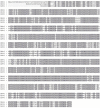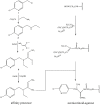Functional interaction of nicotinic acetylcholine receptors and Na+/K+ ATPase from Locusta migratoria manilensis (Meyen)
- PMID: 25743085
- PMCID: PMC4351541
- DOI: 10.1038/srep08849
Functional interaction of nicotinic acetylcholine receptors and Na+/K+ ATPase from Locusta migratoria manilensis (Meyen)
Abstract
Associated proteins are important for the correct functioning of nicotinic acetylcholine receptors (nAChRs). In the present study, a neonicotinoid-agarose affinity column was used to isolate related proteins from a solubilized membrane preparation from the nervous system of Locusta migratoria manilensis (Meyen). 1530 peptides were identified and most of them were involved in the membranous structure, molecular interaction and cellular communication. Among these peptides, Na(+)/K(+) ATPase had the highest MASCOT score and were involved in the molecular interaction, which suggested that Na(+)/K(+) ATPase and nAChRs might have strong and stable interactions in insect central nervous system. In the present study, functional interactions between nAChRs and Na(+)/K(+) ATPase were examined by heterologous expression in Xenopus oocytes. The results showed that the activated nAChRs increased pump currents of Na(+)/K(+) ATPase, which did not require current flow through open nAChRs. In turn, Na(+)/K(+) ATPase significantly increased agonist sensitivities of nAChRs in a pump activity-independent manner and reduced the maximum current (Imax) of nAChRs. These findings provide novel insights concerning the functional interactions between insect nAChRs and Na(+)/K(+) ATPase.
Figures






Similar articles
-
Alternative splicing in nicotinic acetylcholine receptor subunits from Locusta migratoria and its influence on acetylcholine potencies.Neurosci Lett. 2017 Jan 18;638:151-155. doi: 10.1016/j.neulet.2016.12.041. Epub 2016 Dec 19. Neurosci Lett. 2017. PMID: 28007651
-
Selective actions of Lynx proteins on different nicotinic acetylcholine receptors in the locust, Locusta migratoria manilensis.J Neurochem. 2015 Aug;134(3):455-62. doi: 10.1111/jnc.13151. Epub 2015 Jun 1. J Neurochem. 2015. PMID: 25951893
-
The functional interaction between nicotinic acetylcholine receptors and Ly-6/neurotoxin proteins in Locusta migratoria.Neurochem Int. 2017 Sep;108:381-387. doi: 10.1016/j.neuint.2017.05.015. Epub 2017 May 19. Neurochem Int. 2017. PMID: 28532679
-
[From diversity of molecular forms to functional specialization of oligomeric proteins, nicotinic acetylcholine receptor, acetylcholinesterase and Na+, K+-ATPase].Tsitologiia. 2004;46(2):89-104. Tsitologiia. 2004. PMID: 15174348 Review. Russian.
-
Phosphorylation of the Na+,K+-ATPase and the H+,K+-ATPase.FEBS Lett. 2010 Jun 18;584(12):2589-95. doi: 10.1016/j.febslet.2010.04.035. Epub 2010 Apr 22. FEBS Lett. 2010. PMID: 20412804 Review.
Cited by
-
Distinct α2 Na,K-ATPase membrane pools are differently involved in early skeletal muscle remodeling during disuse.J Gen Physiol. 2016 Feb;147(2):175-88. doi: 10.1085/jgp.201511494. Epub 2016 Jan 11. J Gen Physiol. 2016. PMID: 26755774 Free PMC article.
-
A sublethal dose of a neonicotinoid insecticide disrupts visual processing and collision avoidance behaviour in Locusta migratoria.Sci Rep. 2017 Apr 20;7(1):936. doi: 10.1038/s41598-017-01039-1. Sci Rep. 2017. PMID: 28428563 Free PMC article.
-
Cholesterol and the Safety Factor for Neuromuscular Transmission.Int J Mol Sci. 2019 Feb 28;20(5):1046. doi: 10.3390/ijms20051046. Int J Mol Sci. 2019. PMID: 30823359 Free PMC article. Review.
-
Specialized Functional Diversity and Interactions of the Na,K-ATPase.Front Physiol. 2016 May 25;7:179. doi: 10.3389/fphys.2016.00179. eCollection 2016. Front Physiol. 2016. PMID: 27252653 Free PMC article. Review.
References
-
- Sattelle D. B. & Breer H. Cholinergic nerve-terminals in the central-nervous-system of insects - molecular aspects of structure, function and regulation. J. Neuroendocrinol. 2, 241–256 (1990). - PubMed
-
- Matsuda K. et al. Neonicotinoids: Insecticides acting on insect nicotinic acetylcholine receptors. Trends Pharmacol. Sci. 22, 573–580 (2001). - PubMed
-
- Geng C., Watson G. B. & Sparks T. C. Nicotinic Acetylcholine Receptors as Spinosyn Targets for Insect Pest Management Target Receptors in The Control of Insect Pests: Part I. Cohen E. (ed.) 101–210 (Academic Press, London, 2013).
-
- Sattelle D. B. et al. Nereistoxin - actions on a CNS acetylcholine-receptor ion channel in the cockroach Periplaneta americana. J. Exp. Biol. 118, 37–52 (1985).
Publication types
MeSH terms
Substances
LinkOut - more resources
Full Text Sources
Other Literature Sources

